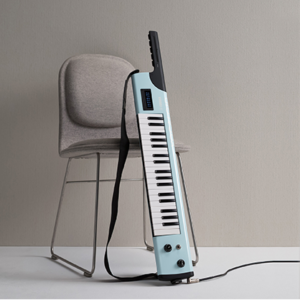A day with excessive heat and humidity can strand you indoors as effectively as a New England snow storm. Time for a virtual quest into parts unknown.
I stumbled onto this beautiful web page on the Japanese Yamaha web site. Lo and behold, a Vocaloid™ keyboard in the shape of a keytar. I strongly suggest visiting this page as the commercial photography is quite stunning in itself.
The Vocaloid keyboard is a prototype that was shown at the “Two Yamahas, One Passion” exhibition at Roppongi Hills, Tokyo, July 3-5, 2015. Some form of Vocaloid keyboard has been in the works for several years and this prototype is the latest example.
The overarching idea is to liberate Vocaloid from the personal computer and to create an untethered performance instrument. The Vocaloid engine is built into the keyboard. The keyboard also has a built-in speaker along with the usual goes-outtas. The industrial design — by Kazuki Kashiwase — tries to create the impression of a wind instrument such as a saxophone.
The performer must preload the lyrics into the instrument before performing. This lets the performer concentrate on the melody when performing, not linguistics. The keyboard adjusts the pitch and timing of the vocalization. The left-hand neck buttons navigate through the lyrics: back one note, advance phrase, go to the end, etc. The ribbon controller raises and lowers the pitch. Control knobs select vibrato, portameno, brightness, breath and gender. Other knobs set the volume and select lyrics. Up to five lyrics can be saved.
The prototype synthesizes the “VY1” Japanese female voice developed by Yamaha for Vocaloid version 2. Somewhat confusingly, “VY1” stands for “Vocaloid Yamaha 1.” The voice has the codename “Mizki.”
The Vocaloid engine is based on the Yamaha Vocaloid Board, not eVocaloid which is built into the NSX-1 integrated circuit (LSI). Yamaha sell the Vocaloid Board to OEMs, eventually intending to incorporate the board into entertainment, karaoke and musical instrument products of its own. The Vocaloid Board has MIDI IN/OUT, by the way, and reads the vocal database from an SD card.
Many of these details are taken from the article by Matsuo Koya (ITmedia). Please see the article for close-up photographs of the Vocaloid keyboard prototype.
The NSX-1 IC (YMW 820) mentioned above is a very interesting device itself. The NSX-1 is a single chip solution designed for embedded (“eVocaloid”) applications. It uses a smaller sized voice database, “eVY1”.
The NSX-1 has a General MIDI level 1 engine. Plus, the NSX-1 has a separate engine to reproduce high quality acoustic instrument sounds thanks to “Real Acoustic Sound” technology. This technology is based on Articulation Element Modeling (AEM) which forms the technical basis of Tyros 5 Super Articulation 2 (S.Art2) voices. Real Acoustic Sound and eVocaloid cannot be used simultaneously.
Holy smokes! I conjectured that AEM and Vocaloid are DSP
siblingscousins. This is further evidence in support of that conjecture.
NSX-1 can be controlled using a Javascript library conforming to the Web MIDI API. Wanna make your browser sing? Check out the Yamaha WebMusic page on github.
The company Switch Science sells an eVY1 SHIELD for Arduino. Kit-maker Gakken Educational has developed a stylus gadget based on eVocaloid and the NSX-1 — Pocket MIKU. And, of course, here is the Pocket Miku video.
Only 13 more days until Summer NAMM 2017.
Copyright © 2017 Paul J. Drongowski

